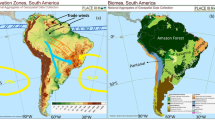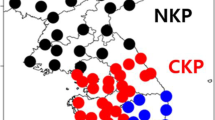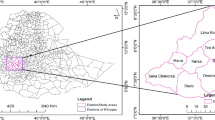Abstract
The Northern Hemisphere winter-season wet day climatology is extremely important to hydrological and agricultural processes of the Himalayan region (HR). However, knowledge of expected changes in the winter-season wet day climatology under global warming is significantly limited. Hence, this study attempts to quantify the expected changes in winter-season wet day climatological patterns for HR during 2020–2099 in comparison to a baseline period of 1980–2000 under two different warming scenarios, these being representative concentration pathways 4.5 and 8.5 (RCP 4.5 and RCP 8.5). Five climate model products covering the southern Asian region were obtained from the Commonwealth Scientific and Industrial Research Organization initiated Coordinated Regional Climate Downscaling Experiment (CORDEX) of the World Climate Research Programme and used for this purpose. Model biases are estimated with respect to observations for a base line period of 1980–2000. Model ensemble non-linear trends of the winter-season wet days for the periods 2020–2040, 2041–2070, and 2071–2099 are estimated using Sen’s slope estimator, while ensemble average future changes in the number of winter-season wet days are estimated, and attempts made to identify the topographical ranges that are expected to be mostly affected by the changing winter-season wet day climatology. The results show that the CORDEX-regional climate models have a positive bias, ranging between 1 and 30 days, across the high altitudes of the entire Himalayas, and model performance improves with an increasing number of wet days per season. Although the impact of stronger warming (i.e. under RCP 8.5) is noted to enhance the area averaged non-linear trend of wet days over northwestern (0.014) and eastern (0.005) Himalaya during 2071–2099, the model ensemble predicted area-averaged reduction in the frequency of wet days of 0.3 to 1.0 day is highly likely by the end of this century. It is also observed that the Himalayan region within the range of 1000–2500 m above sea level may experience a decline in winter-season wet days by up to 0.8 to 3.2 days under the warming scenarios of both RCP 4.5 and 8.5.









Similar content being viewed by others
References
Beniston M (2003) Climate change in mountain regions: a review of possible impacts. Clim Chang 59(1):5–31
Bhutiyani M, Kale V, Pawar N (2007) Long-term trends in maximum, minimum, and mean annual air temperatures across the northwestern Himalaya during the 20th century. Clim Chang 85:159–177
Bookhagen B, Burbank D (2006) Topography, relief, and TRMM-derived rainfall variations along the Himalaya. Geophys Res Lett 33:L08405. https://doi.org/10.1029/2006GL026037
Chalise S, Khanal N (2001) Rainfall and related natural disasters in Nepal. In: Tianchi Li, Chalise S, Upreti BN (eds) Landslide hazards, mitigation to the Hindukush-Himalayas ICIMOD, Nepal
Dash S, Sharma N, Pattnayak K, Gao X, Shi Y (2012) Temperature and precipitation changes in the north-east India and their future projections. Glob Planet Chang 98:31–44
Dhar O, Rakhecha P (1981) The effect of elevation on monsoon rainfall distribution in the central Himalayas. In: Lighthill J, Pearce RP (eds) Monsoon dynamics. Cambridge University Press, Cambridge
Dikshit KR, Dikshit JK (2014) North-east India: Land people and economy. Springer, Netherlands
Dimri AP (2006) Surface and upper air fields during extreme winter precipitation over the western Himalayas. Pur Appl Geophys 163(8):1679–1698
Dimri AP (2014) Sub-seasonal interannual variability associated with the excess and deficit Indian winter monsoon over the Western Himalaya. Clim Dyn 42(7-8):1793–1805
Dimri AP, Niyogi D (2013) Regional climate model application at subgrid scale on Indian winter monsoon over the western Himalayas. Int J Climatol 33(9):2185–2205. https://doi.org/10.1002/joc.3584
Dimri AP, Niyogi D, Barros A, Ridley J, Mohanty UC, Yasunari T, Sikka D (2015) Western disturbances: A review. Rev Geophys 53:225–246
Dimri AP, Kumar D, Choudhary A, Maharana P (2018) Future changes over the Himalayas: Mean temperature. Glob Planet Chang 162:235–251. https://doi.org/10.1016/j.gloplacha.2018.01.014
Dyurgerov MB, Meier MF (2005) Glaciers and the changing earth system: a 2004 snapshot, vol 58 Institute of Arctic and Alpine Research, University of Colorado Boulder, USA
Ghimire S, Choudhary A, Dimri AP (2015) Assessment of the performance of CORDEX-South Asia experiments for monsoonal precipitation over the Himalayan region during present climate: part I. Clim Dyn. https://doi.org/10.1007/s00382-015-2747-2
Giorgi F, Bi X, Pal J (2004) Mean, interannual variability and trends in a regional climate change experiment over Europe. II: climate change scenarios (2071-2100). Clim Dyn 23(7–8):839–858
Giorgi F, Bates GT (1989) The climatological skills of a regional model over complex terrain. Mon Weather Rev 117(11):2325–2347
Goyal M, Singh V, Meena A (2015) Geospatial and hydrological modeling to assess hydropower potential zones and site location over rainfall dependent inland catchment. Water Res Manag 29:2875–2894. https://doi.org/10.1007/s11269-015-0975-1
Hatwar H, Yadav BP, Rama Rao YV (2005) Prediction of western disturbances and associated weather over Western Himalaya. Curr Sci 88:913–920
IPCC (2014) Impacts, adaptation and vulnerability. Part B: regional aspects. Contribution of working gropu II to the fifth assessment report of IPCC Tech, Rep., Cambridge University Press
Kanwal M, Mukherjee S, Joshi R, Rai S (2019) Impact assessment of changing environmental and socio-economic factors on crop yields of central Himalaya with emphasis to climate change. Environ Ecol 37(1B):324–332
Kulkarni A, Patwardhan S, Krishna Kumar S, Karamuri A, Krishnan R (2013) Projected climate change in the Hindu Kush-Himalayan region by using the high-resolution regional climate model PRECIS. Mt Res Dev 33:142–151
Kumar P, Wiltshire A, Mathison C, Asharaf S, Ahrens B, Lucas-Picher P, Jacob D et al (2013) Downscaled climate change projections with uncertainty assessment over India using a high-resolution multimodel approach. Sci Total Environ 468:S18–S30
Maharana P, Dimri AP (2014) Impact of initial and boundary conditions on regional winter climate over Western Himalayas: a fixed domain size experiment. Glob Planet Chang 114:1–13
Mall R, Gupta A, Singh R, Singh R, Rathore L (2006) Water resources and climate change:An Indian perspective. Curr Sci 90(12):1610–1626
McGregor J, Dix M (2001) The CSIRO conformal-cubic atmospheric GCM. IUTAM symposium on advances in mathematical modeling of atmospheric and ocean dynamics pp 197–202
Midhuna T, Dimri A (2019) Future projection of winter precipitation over northwest India and associated regions using CORDEX-SA experiments. Theor Appl Climatol. https://doi.org/10.1007/s00704-019-03049-7
Mishra V (2015) Climatic uncertainty in Himalayan water towers. J Geophys Res. https://doi.org/10.1002/2014JD022650
Mukherjee S, Shukla R, Mittal A, Pandey A (2011) Mathematical analysis of a chaotic model in relevance to monsoon ISO. Met Atmos Phys 114:83–93
Mukherjee S (2017) Contrasting predictability of summer monsoon rainfall ISOs over the northeastern and western Himalayan region: an application of Hurst exponent. Meteorol Atmos Phys. https://doi.org/10.1007/s00703-017-0551-8
Mukherjee S, Joshi R, Prasad R, Vishvakarma S, Kumar K (2015) Summer monsoon rainfall trends in the Indian Himalayan region. Theor Appl Climatol 121(3-4):789–802. https://doi.org/10.1007/s00704-014-1273-1
Mukherjee S, Ballav S, Soni S, Kumar K, De UK (2016) Investigation of dominant modes of monsoon ISO in the northwest and eastern Himalayan region. Theor Appl Climatol 125(3-4):489–498. https://doi.org/10.1007/s00704-015-1512-0
Mukherjee S, Hazra A, Kumar K, Nandi S, Dhyani P (2019) Simulated projection of ISMR over Indian Himalayan region: assessment from CSIRO-CORDEX South Asia experiments. Meteorol Atmos Phys 131(1):63–79. https://doi.org/10.1007/s00703-017-0547-4
Mukherjee S, Gosavi V, Joshi R, Kumar K (2020) Impact of Nino phases on the summer monsoon of northwestern and eastern Himalaya. In: Himalayan weather and climate and their impact on the environment. https://doi.org/10.1007/978-3-03029684-1_2. Springer Nature
Mukherjee S (2021) Nonlinear recurrence quantifications of the monsoon-season heavy rainy-days over northwest Himalaya for the baseline and future periods. Sci Total Environ 789(7):147754. https://doi.org/10.1016/j.scitotenv.2021.147754
Nageshwararao M, Mohanty U, Ramakrishna S, Nair A, Kiran Prasad S (2016) Characteristics of winter precipitation over northwest India using high-resolution gridded dataset (1901-2013). Glob Planet Chang 147:67–85. https://doi.org/10.1016/j.gloplacha.2016.10.017
Nandargi A, Dhar O (2011) Extreme rainfall events over Himalaya between 1871 and 2007. Hydro Sci J 56(6):930–945
Palazzi E, Hardenber J, Terzago S, Provenzale A (2013) Precipitation in the Hindukush-Karakoram Himalaya: Observation and future scenarios. J Geophys Res - Atmos 118:85–100. https://doi.org/10.1029/2012JD018697
Parthasarathy B, Munot A, Kothawale D (1994) All-India monthly and seasonal rainfall series: 1871-1993. Theor Appl Climatol 49:217–224
Pattanaik D, Rajeevan M (2010) Variability of extreme rainfall events over India during southwest monsoon season. Meteorol Appl 17:88–104
Pisharoty P, Desai B (1956) Western disturbances and Indian weather. Mausam 7:333–338
Pohl B, Macron C, Monerie PA (2017) Fewer rainy days and more extreme rainfall by the end of the century in South Africa. Sci Rep 7:46466. https://doi.org/10.1038/srep46466
Rummukainen M (2010) State-of-the-art with regional climate models. Wiley Interdiscip Rev Clim Chang 1(1):82–96
Sanjay J, Krishnan R, Shrestha A, Rajbhandari R, Ren GY (2017) Downscaled climate change projections for the Hindu Kush Himalayan region using CORDEX South Asia regional climate models. Adv Clim Chang Res 8(3):185–198. https://doi.org/10.1016/j.accre.2017.08.003
Sen P (1968) Estimates of the regression coefficient based on Kendall’s tau. J Amer Stat Assoc 39:1379–1389
Singh SP, Khadka BI, Karky B, Sharma E (2011) Climate change in the Hindu Kush Himalaya: the state of current knowledge. ICIMOD, Nepal
Solman SA, Nunez MN, Cabre MF (2008) Regional climate change experiments over southern South America. I: present climate. Clim Dyn 30(5):533–552
Wiltshire A (2014) Climate change implications for the glaciers of the Hindu Kush, Karakoram and Himalayan region. Cryosphere 8:941–958. https://doi.org/10.5194/tc-8-941-2014
Yadav R (2009) Role of equitorial central Pacific and northwest of North Atlantic 2-meter surface temperature in modulating Indian summer monsoon variability. Clim Dyn 32(4):549–563. https://doi.org/10.1007/s00382-008-0410-x
Yatagai A, Arakawa O, Kamiguchi K, Kawamoto H, Nodzu M, Hamada A (2009) A 44-year daily gridded precipitation dataset for Asia based on a dense network of rain gauges. Sci Online Lett Atmos 5:137–140
Yatagai A, Kamiguchi K, Arakawa O, Hamada A, Yasutomi N, Kitoh A (2012) APHRODITE: Constructing a long-term daily gridded precipitation dataset for Asia based on a dense network of rain gauges. Bul Amer Meteorol Soc 93:1401–1415
Acknowledgements
The World Climate Research Programme’s Working Group on Regional Climate, and the Working Group on Coupled Modelling, the former coordinating body of CORDEX and responsible panel for CMIP5 are gratefully acknowledged. The Centre for Climate Change Research, Indian Institute of Tropical Meteorology, Pune, India, is acknowledged for providing CORDEX South Asia data. Prof. Andrew Sturman, University of Canterbury, New Zealand is acknowledged for improving the language of this manuscript.
Funding
SM received research project grant from NMHS, MoEFCC, GOI, (NMHS-2017-18/MG-02/478), for this work.
Author information
Authors and Affiliations
Corresponding author
Ethics declarations
Ethics approval and consent to participate
Not applicable
Consent for publication
Consents for publication from all the co-authors are received.
Conflict of interest
The authors declare no competing interests.
Additional information
Author contribution
SB and SM: conceptualization, data analyses, manuscript writing. VG and APD: conceptualization, results verification and manuscript correction.
Data availability
The World Climate Research Programme’s Working Group on Regional Climate, and the Working Group on Coupled Modelling, former coordinating body of CORDEX and responsible panel for CMIP5 are gratefully acknowledged. The CORDEX data was obtained from Centre for Climate Change Research, Indian Institute of Tropical Meteorology, Pune, India.
Code availability
The data analysis codes are available from SB and SM and can be shared after necessary approval from Competent Authority of GBPNIHE, India.
Publisher’s note
Springer Nature remains neutral with regard to jurisdictional claims in published maps and institutional affiliations.
Rights and permissions
About this article
Cite this article
Ballav, S., Mukherjee, S., Gosavi, V. et al. Projected changes in winter-season wet days over the Himalayan region during 2020–2099. Theor Appl Climatol 146, 883–895 (2021). https://doi.org/10.1007/s00704-021-03765-z
Received:
Accepted:
Published:
Issue Date:
DOI: https://doi.org/10.1007/s00704-021-03765-z




